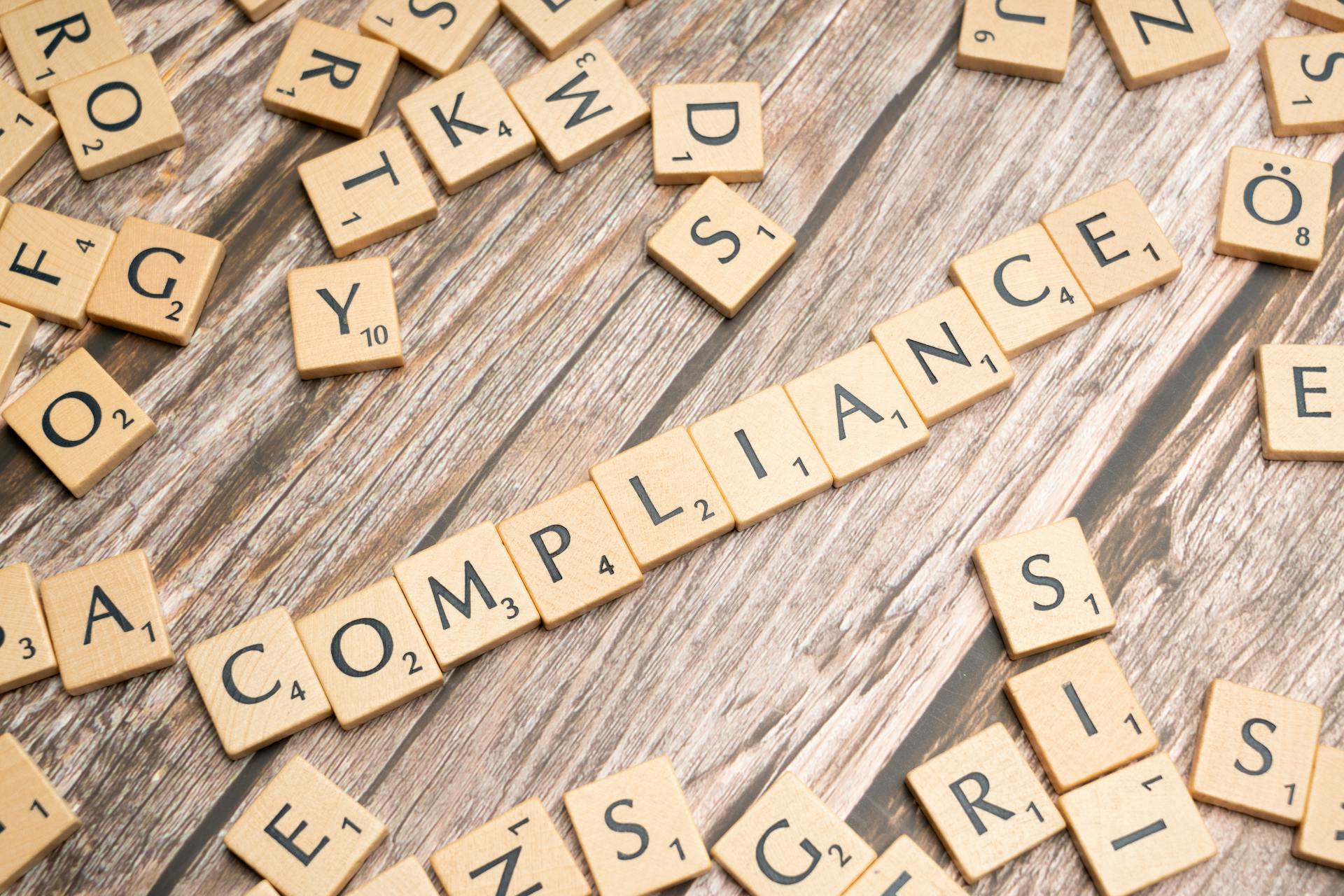
Becoming PCI compliant is a crucial step for businesses that handle credit card information. The Payment Card Industry Data Security Standard (PCI DSS) is a set of requirements that must be met to ensure the secure handling of this sensitive data.
The PCI DSS is set by the major credit card companies, including Visa, Mastercard, and American Express. Compliance is mandatory for any business that processes, stores, or transmits credit card information.
To become PCI compliant, your business must implement various security measures, such as firewalls, intrusion detection systems, and encryption.
Understanding PCI Compliance
PCI compliance is a must for any merchant who accepts credit cards as a form of payment, regardless of business size or volume. This is because PCI DSS compliance protects sensitive cardholder data from physical and digital breaches.
To become PCI compliant, you'll need to go through a series of steps, which include determining your PCI level, performing an assessment, and submitting required documentation. This process can be overwhelming, especially with the PCI DSS standard containing almost 2000 pages of documentation.
The good news is that you can start by checking your eligibility and downloading the PCI DSS Self-Assessment Questionnaire to get a clear picture of where you stand.
Here are the key steps to determine your PCI level:
- PCI DSS Scoping: Determining which system components and networks are in scope for PCI DSS for your business.
- Assessment: Examining the compliance of system components in scope following the testing procedures for each PCI DSS requirement.
- Reporting: The assessor or entity submits required documentation, like the Self-Assessment Questionnaire (SAQ) or Report on Compliance (ROC), including documentation of all compensating controls.
What Is PCI Compliance?
PCI compliance is a set of security standards designed to ensure that companies that handle credit card information protect it from unauthorized access.
These standards are set by the Payment Card Industry Security Standards Council (PCI SSC), a consortium of major credit card companies.
To be PCI compliant, companies must adhere to a strict set of guidelines, including implementing firewalls, encrypting data, and regularly updating software.
This helps prevent data breaches and protect sensitive information from falling into the wrong hands.
Companies that store, process, or transmit credit card information must comply with these standards, regardless of their size or industry.
This includes businesses of all types, from small retail stores to large online marketplaces.
Recommended read: Pci Dss Information Security Policy
The PCI compliance process involves a series of assessments and audits to ensure that companies are meeting the required standards.
These assessments can be conducted by a qualified security assessor or by the company itself.
The goal of PCI compliance is to protect cardholder data and prevent unauthorized access.
This helps to build trust with customers and maintain a positive reputation in the industry.
Why Is It Required?
PCI DSS certification is required to protect sensitive cardholder and authentication data, whether stored, transmitted, or processed.
In fact, 30% of small businesses report that they don't know the penalties for non-compliance with PCI DSS 4.0, which is a significant concern.
Your business must always be compliant, and if you accept credit card brands like American Express, JCB International, VISA, and more, you should validate your compliance annually.
This applies to all companies that collect, process, and transmit credit card data, including global enterprises and start-ups.
A different take: Pci Compliance for Storing Credit Card Information
If you accept or process credit card payments as a service provider, you must comply with PCI DSS requirements based on the security policy.
The PCI DSS standard lays down 250+ essential controls applicable to merchants and service providers that use card information to remain PCI compliant.
This includes implementing technical safeguards to protect cardholder data, such as access controls and password management, physical security, and measures and documentation of the existing security program's policies.
Broaden your view: Cyber Security Pci Compliance
Becoming PCI Compliant
To become PCI compliant, you need to go through a series of steps. First, determine if your business needs to be PCI compliant, which is a must for any merchant who accepts credit or debit cards, regardless of size.
You'll need to validate PCI compliance at each individual location if your business has multiple locations with separate tax ID numbers. If all locations operate under one tax ID, you're typically only required to validate PCI compliance annually for all locations.
Here are the essential steps to becoming PCI compliant: Get familiar with the 12 PCI DSS requirements, which are distributed among six goals necessary for any company to comply with PCI compliance requirements.Map your internal controls to PCI DSS goals and protect points where card data enters, gets stored, and exits the organization.Submit an Audit Report or SAQ, which will be defined by the volume of transactions your organization processes annually.
Recommended read: Pci Compliance for Small Businesses
Benefits
Becoming PCI Compliant offers numerous benefits that can have a significant impact on your business. Implementing PCI DSS Compliance guidelines enhances your overall security posture and protects you from data breaches.
Employing strong security controls with strong cryptography and best practices builds an optimised security stance and enhances operational efficiency. It also helps manage risks proactively and fosters a compliance culture.
A number of large enterprises seek PCI compliant vendors, which can help unlock corporate expansion for your business. Customers find it easy to mortgage their trust with your business with compliance confidence, knowing their data is safe and handled securely.
Two-thirds of US adults wouldn't return to a business after a data breach, highlighting the importance of customer trust. Customers view PCI compliance as a sign that your business follows best practices, which can have a big impact on your brand and profits.
Here are some of the benefits you'll receive directly or indirectly when you become PCI-compliant:
- Strong security controls with strong cryptography and best practices
- Management of risks proactively
- Compliance culture fostered
- Increased customer trust
- Unlocking corporate expansion
- Confidence in data safety and handling
Determine Your Requirements

You need to determine your PCI level to know how to become PCI compliant. This is your first step.
Your business's size and volume of transactions will help determine your PCI level. Merchants who process more than 6 million transactions per year are classified as Level 1, while those who process fewer than 20,000 transactions per year are classified as Level 4.
Here are the different PCI levels and what they entail:
- Level 1: Merchants who process more than 6 million transactions per year must undergo a more rigorous compliance validation.
- Level 2, 3, and 4: Merchants in these categories can complete a yearly Self-Assessment Questionnaire (SAQ) and may need to conduct quarterly network vulnerability scans.
Keep in mind that if your business has multiple locations with separate tax ID numbers, you'll need to validate PCI compliance at each individual location. If all of your locations operate under one tax ID, you're typically only required to validate PCI compliance annually for all locations.
Map Policies and Controls
Mapping policies and controls is a crucial step in becoming PCI compliant. This involves identifying and eliminating out-of-scope items to ensure a lean audit preparation period.
To manually map 250+ controls for the 12 security standards is not an option, so consider automating the PCI compliance process. Automating the process provides a unified view of your controls and policies.
The PCI framework has 12 security standards, and manually mapping each control is not feasible. Consider using a compliance automation platform like Sprinto to simplify the process.
Sprinto's compliance automation platform allows you to map your controls to the specific requirements of the PCI framework. This provides a live status of your controls, making monitoring effortless.
With Sprinto, you can map your controls to the 6 key goals of PCI DSS compliance and break them down into entities. This ensures that your business has all the necessary controls and checks for a seamless audit.
Implementing a diligent information security policy is essential for PCI compliance. This involves examining your security controls and protocols to identify potential risks and gaps.
Examine your security controls and protocols to identify potential risks and gaps in your cardholder data environment. Collaborate with your IT and security teams to identify the right controls and establish the correct security settings and protocols.
Expand your knowledge: Pci Dss Framework
Employee Training Required
You must train your employees about PCI compliance. There are online courses and videos to help you.
Non-compliance with PCI requirements can result in severe consequences, including fines ranging from $5,000 to $10,000 per month until you reach compliance.
To ensure continuous policy implementation, conduct annual staff training. This is a crucial step in formulating a clear infosec policy.
Here's what you need to do for staff training:
- Ensure all employees understand the importance of PCI compliance
- Document the training and keep records
Don't underestimate the importance of employee training. It's a key factor in maintaining PCI compliance and avoiding costly fines.
Implementation and Security
To become PCI compliant, you need to implement a vulnerability management program that periodically scans your network and operating systems for breaches and cyberattacks. This program should use measures such as patch management, vulnerability scanning, and configuration management to protect data, detect weaknesses, and prevent future attacks.
A diligent information security policy is also crucial, which includes steps such as defining and implementing processes to identify and classify risk for technology deployment, and applying patches in a timely manner.
You'll also need to deploy secure systems and applications, and implement the right security controls, such as Transport Layer Security (TLS) for secure data transmission. Regular internal PCI DSS audits will help you check if you're following PCI DSS rules, and a gap analysis exercise can identify deficient controls that could lead to a failed audit report.
To ensure ongoing systems and process testing, you'll need to conduct periodic wireless analyzer scanning, internal vulnerability scans, and a thorough application and network penetration test annually. This will help you prevent data breaches and ensure you have everything in place to stop a big breach from happening.
Here's a list of key steps to implement and maintain security:
- Create a plan for firewall implementation and policy for changes or updates
- Monitor and test your firewall periodically to detect potential vulnerabilities
- Update your firewall with the latest patches and ensure overall maintenance
Internal Risk Assessment
An internal risk assessment is a crucial step in ensuring the security of your payment environment. It helps identify risks related to information systems and decides how they will be controlled and managed.
To conduct an internal risk assessment, you'll need to draw a line between production and non-production systems. This is essential to prevent any potential security breaches from affecting your live systems.
Make an inventory of your critical systems and internal controls, including any software, hardware, and network configurations. This will help you identify potential vulnerabilities and areas for improvement.
Identify business risks, assign a likelihood and impact to each of them, and deploy policies and procedures to mitigate them. This will help you prioritize your risk management efforts and allocate resources effectively.
Here's a step-by-step guide to conducting an internal risk assessment:
- Draw a line between production and non-production systems
- Make an inventory of the critical systems and internal controls
- Identify business risks, assign a likelihood and impact to each of them
- Deploy policies and procedures to mitigate them
By following these steps, you'll be able to identify and manage risks in your payment environment, reducing the likelihood of security breaches and protecting your customers' sensitive information.
Secure Network Setup and Maintenance
To set up a secure network, start by installing firewalls on your computers and internal network, as well as configuring your firewall and routers to protect your payment card data environment.
Firewalls are essential for restricting incoming and outgoing network traffic and preventing hackers from accessing your system. You'll also need to establish firewall and router rules and standards that determine which types of traffic are allowed and which aren't.
Create a plan for firewall implementation and policy for changes or updates to ensure your firewall is properly configured and maintained. Monitor and test your firewall periodically to detect potential vulnerabilities.
Update your firewall with the latest patches and ensure overall maintenance to prevent security breaches.
Here's a checklist to help you get started:
- Install firewalls on your computers and internal network
- Configure your firewall and routers to protect your payment card data environment
- Establish firewall and router rules and standards
- Create a plan for firewall implementation and policy for changes or updates
- Monitor and test your firewall periodically
- Update your firewall with the latest patches and ensure overall maintenance
Compliance Process
To become PCI compliant, you'll need to go through a series of steps. First, you'll need to determine which system components and networks are in scope for PCI DSS for your business, known as PCI DSS Scoping.
You'll then need to examine the compliance of these system components in scope following the testing procedures for each PCI DSS requirement, which is called an Assessment. This process involves submitting required documentation, such as the Self-Assessment Questionnaire (SAQ) or Report on Compliance (ROC), including documentation of all compensating controls.
Expand your knowledge: Pci Dss Scope
Here are the key steps to understand in the compliance process:
- PCI DSS Scoping: Determining which system components and networks are in scope for PCI DSS for your business.
- Assessment: Examining the compliance of system components in scope following the testing procedures for each PCI DSS requirement.
- Reporting: The assessor or entity submits required documentation, like the Self-Assessment Questionnaire (SAQ) or Report on Compliance (ROC), including documentation of all compensating controls.
- Clarifications: The assessor or entity clarifies or updates report statements (if applicable) upon request of the acquiring bank or payment card brand.
It's also worth noting that, depending on your merchant classification or risk level, you may need to pass network scans for each location on a quarterly basis.
Report Submission
As you near the end of the compliance process, it's essential to understand the report submission requirements.
You'll need to submit detailed records of the entire process, from the start of the assessment to any required remediation. These reports must be submitted to any card networks you have a relationship with as well as your acquiring bank.
To ensure you're meeting the necessary requirements, keep all validation documentation readily available.
You'll need to submit required documentation, such as the Self-Assessment Questionnaire (SAQ) or Report on Compliance (ROC), including documentation of all compensating controls.
Here are some key report submission terms to understand:
By submitting accurate and complete reports, you'll be well on your way to achieving PCI DSS compliance.
Ongoing Testing
Ongoing testing is a crucial part of maintaining PCI compliance. It's essential to stay one step ahead of malicious actors who are constantly trying to exploit vulnerabilities.
You'll need to conduct internal and external vulnerability scans at least quarterly, and always after any major network change. A qualified professional must complete the scan, and any detected vulnerabilities must be addressed.
Malicious actors are constantly probing systems for weaknesses, so it's essential to stay on top of testing. You'll need to conduct periodic wireless analyzer scanning on a quarterly basis to identify unauthorized access points.
Here's a breakdown of the testing requirements:
Remember, penetration testing must be performed annually, and it's essential to determine how malicious actors could gain access to valuable information and security assets.
Ongoing Compliance
Ongoing compliance is a crucial aspect of maintaining PCI compliance. It's not a one-time task, but rather an ongoing process that requires continuous monitoring and assessment.
You'll need to conduct periodic wireless analyzer scanning on a quarterly basis to identify unauthorized access points. This is a requirement of PCI standards, which include continuous system and process testing to prevent malicious actors from exploiting vulnerabilities.
To ensure airtight controls, you'll need a continuous monitoring mechanism. This can be achieved through automated checks, which can be run at regular intervals to ensure compliance never falls through the cracks.
Some payment card brands may require you to send reports regularly, especially if you process a lot of payment card transactions. In this case, you'll need to have a system in place to ensure continuous compliance.
Continuous monitoring can be automated, empowering your business to move away from the cyclic/periodic monitoring model. This allows you to focus on more hands-on tasks and respond quickly to new instances that may arise.
Here's a breakdown of the types of monitoring and assessment models:
- Periodic monitoring: Conducted at regular intervals, such as quarterly or annually.
- Cyclic monitoring: Triggered by specific events, such as a new user being added or a patch being released.
- Automated monitoring: Runs continuously in the background, providing real-time visibility and alerting you to any issues.
By implementing a continuous monitoring mechanism, you can ensure that your business remains PCI compliant throughout the year. This will give you peace of mind and help you avoid any potential fines or penalties associated with non-compliance.
Security Measures
To become PCI compliant, it's essential to implement robust security measures. A secure network is a great starting point, which includes installing firewalls and antivirus software on your computer network and using a private internet connection that's password protected.
You should also restrict access to any confidential payment data to select trustworthy users. This means using authentication methods such as multi-factor authentication (MFA), unique usernames and passwords, pins and security tokens to minimize the risk of a breach or unauthorized login.
A diligent information security policy is also necessary, which involves conducting a thorough risk assessment before deploying secure systems and applications. This includes identifying and classifying risk for the sake of technology deployment.
After conducting a risk assessment, you can begin rolling out equipment and software used in processing or handling sensitive payment card information. Don't forget to apply patches in a timely manner, including patches for items like databases, point-of-sale terminals, and operating systems.
Examine your security controls and protocols to ensure they're adequate, including establishing the correct security settings and protocols such as Transport Layer Security (TLS) for secure data transmission.
If this caught your attention, see: Card Data Covered by Pci Dss Includes
Increases Customer Trust
Becoming PCI compliant is a big deal for your business, and one of the most important reasons is that it increases customer trust. Most people wouldn't support a business if they thought their credit card data might get stolen.
Customers view PCI compliance as a sign that your business follows best practices, and that's a huge confidence booster. People who don't trust you to protect their data are less likely to spend money.
In fact, two-thirds of US adults wouldn't return to a business after a data breach, so it's worth taking the time to get compliant.
For more insights, see: First Data Pci Compliance
Featured Images: pexels.com


